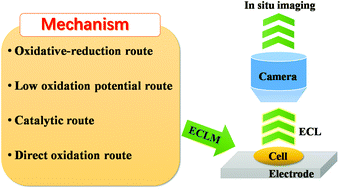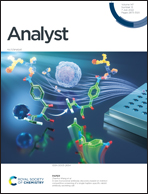Recent progress in electrochemiluminescence microscopy analysis of single cells
Abstract
Electrochemiluminescence (ECL) is produced by chemiluminescence reactions initiated by electrochemical methods. On this basis, ECL microscopy (ECLM) is an emerging visualization tool to directly study local electrochemical features with good spatial and temporal resolution. Recent progress in ECLM demonstrates that it is particularly important in single-cell studies on the morphological structures and functional characteristics of cells due to the unique heterogeneity of cells. Compared with other single-cell imaging methods, ECLM possesses advantages such as a low optical background, high sensitivity, simple instrumentation and surface-confined mode. In this mini-review, we discuss the recent development of single-cell ECLM and classify these works according to different ECL routes. Because ECL routes significantly influence the features of ECLM, such as the thickness of the emitting layer and the brightness of emitters, it is necessary to provide a new insight to revisit these works and discuss what ECL routes can be chosen to study single-cell processes from different perspectives. Considering the gradual growth in single-cell ECLM, we show the developmental trajectory and how these works connect with one another. In addition, the coexisting challenges as well as opportunities inspire us to design more ECLM methods to investigate local electrochemical phenomena.

- This article is part of the themed collections: Analyst HOT Articles 2022 and Analyst Review Articles 2022


 Please wait while we load your content...
Please wait while we load your content...